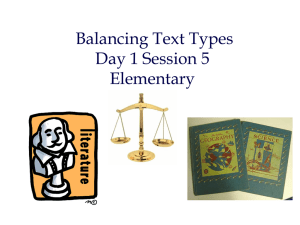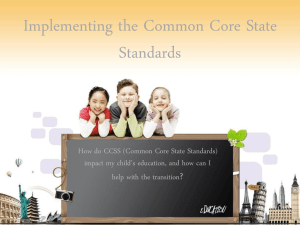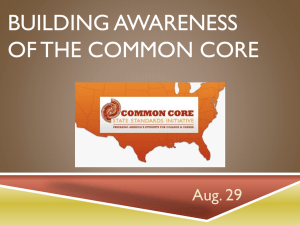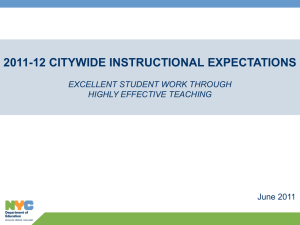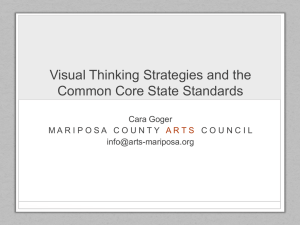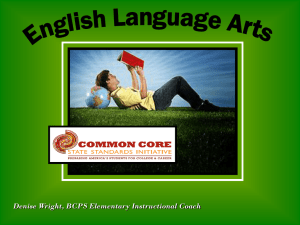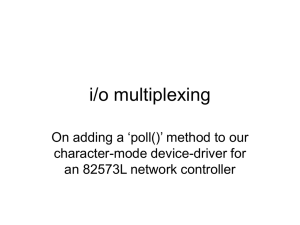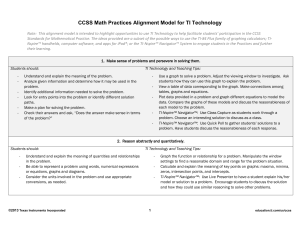ACTFL Common Core Presentation
advertisement
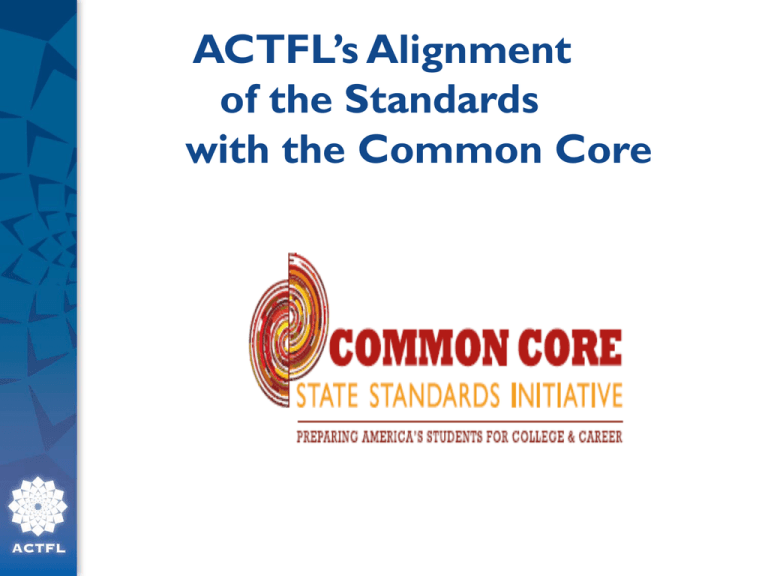
ACTFL’s Alignment of the Standards with the Common Core 1 Presentation Goals Provide an update on ACTFL’s involvement with alignment effort Help you to understanding the connection between the Common Core English Arts Standard and the National Foreign Standards for Foreign Language Learning Encourage feedback Poll Everywhere How familiar are you with the Common Core? Has your State adopted the Common Core? Is your state and/or district working with the Common Core Standards? If yes, has this impacted World Languages? Poll Everywhere, Multiple Choice Number Included in Text Message Contact number you Text to OR you may vote online on the Web. Copy and paste the link into web browser and vote! Texting Example, Multiple Choice Poll Contact Number Input the number associated with your voting choice Via Web Voting, Multiple Choice www.pollev.com Input the number associated with your choice Poll Everywhere, Open Ended Number Included in Text Message Contact number you Text to OR you may vote online on the Web. Copy and paste the link into web browser and vote! Texting Example, Open Ended Poll Contact Number Input the number associated with the poll along with your written response. Via Web Voting, Open Ended www.pollev.com Input the number associated with the poll as well as your written response. Open Ended Results Your responses will show up immediately on the Poll Results. What are the Common Core Standards? “Common Core Standards define the knowledge and skills students should have within their K-12 education careers so that they will graduate high school able to succeed in entry-level, creditbearing academic college courses and in workforce training programs.” (NGA & CCSSO, 2010) CCSS will impact states, districts, educators, parents, students. http://www.corestandards.org/ 11 Impetus for the Common Core State Standards Currently, every state has its own set of academic standards, meaning public educated students are learning different content at different rates All students must be prepared to compete with not only their American peers in the next state, but with students around the world 12 Development of Common Core Standards Joint initiative of: Supported by: -Achieve -College Board and 3 Territories -ACT -48 States 13 What is the Impact of the Common Core? The CCSS mandates the student learning outcomes for every grade level. The CCSS force a common language. Students will be tested and instructional effectiveness will be measured based on CCSS. Federal funding is tied to CCSS adoption, implementation, and accountability. English Language Arts and Mathematics CCSS are just the beginning. . .more subject area standards are being developed. 14 Content of the Common Core ENGLISH LANGUAGE ARTS* MATHEMATICS 15 Portrait of Students Who Meet ELA Standards Students: Demonstrate independence Build strong content knowledge Respond to the varying demands of audience, task, purpose, and discipline Comprehend as well as critique Value evidence Use technology and digital media strategically and capably Come to understand other perspectives and cultures Overview to English Language Arts Standards Common Core Standards for English Language Arts and Literacy in History/Social Studies, Science, and Technical Subjects College and Career Readiness (CCR) Anchor Standards for each strand: • Reading • Speaking and Listening • Writing •Language ▪ Overarching targets for each grade band: K-5, 6-8, 9-10, 11-12 ▪Technical subjects: defined as engineering, technology, business, design, and other workforce-related subjects; technical aspects of wider fields of study such as art and music Strands of English Language Arts Standards Reading: Text complexity and growth of comprehension Grades K-5: Literature and Informational Text Grades K-5: Reading Standards – Foundational Skills Grades 6-12: Literature and Informational Text Writing: Text types, responding to reading, and research Speaking and Listening: Flexible communication and collaboration Language: Conventions and vocabulary A Vision for Implementation 19 TABLE DISCUSSION How is your state/district using the Common Core State Standards? How is the CCSS effort affecting or might it affect your work with World Languages? English Language Arts Standards » Anchor Standards » College and Career Readiness Anchor Standards for Writing Text Types and Purposes 1. Write arguments to support claims in an analysis of substantive topics or texts, using valid reasoning and relevant and sufficient evidence. 2. Write informative/explanatory texts to examine and convey complex ideas and information clearly and accurately through the effective selection, organization, and analysis of content. 3. Write narratives to develop real or imagined experiences or events using effective technique, well-chosen details, and well-structured event sequences. English Language Arts Standards » Anchor Standards » College and Career Readiness Anchor Standards for Reading Key Ideas and Details 1. Read closely to determine what the text says explicitly and to make logical inferences from it; cite specific textual evidence when writing or speaking to support conclusions drawn from the text. 2. Determine central ideas or themes of a text and analyze their development; summarize the key supporting details and ideas. 3. Analyze how and why individuals, events, and ideas develop and interact over the course of a text. Process for the development of the “crosswalk” document. Small panel to develop draft Expert review Draft for presentation at the Delegate Assembly Feedback from the field. Overview of the Draft Document Common Core State Standards-ELA Standards for Learning Languages Reading Interpretive (Reading, Listening, Viewing) Key Ideas and Details 1. Read closely to determine what the text says explicitly and to make logical inferences from it; cite specific textual evidence when writing or speaking to support conclusions drawn from the text 2. Determine central ideas or themes of a text and analyze their development; summarize key supporting details and ideas 3. Analyze how and why individuals, events, or ideas develop and interact over the course of a text Interpretive Communication Students demonstrate comprehension of content from authentic audio and visual resources. Practices and Products of Culture Students examine, compare and reflect on products, practices, and/or perspectives of the target culture(s). Acquiring New Information Students acquire information from other content areas using authentic sources Novice Students Intermediate Students Advanced Students Comprehend main ideas in developmentally appropriate oral/visual narratives based on familiar themes and highly predictable contexts with appropriate support. Understand the main themes and significant details on primarily familiar topics from authentic multimedia and print sources, both informational and narratives with clear storylines. Determine the main ideas and significant details of discussions, lectures, and presentations on current or past events from the target culture or other content areas. When presented with an inference based on an authentic text, identify if the inference is logical or illogical by citing specific textual evidence to support conclusions drawn from the text Interpret the principal elements of technical, informational and narrative literary texts on topics of current and historical importance to the target culture. Interpret informational texts with strong visual support, such as graphs and charts. English Language Arts Standards » SPEAKING AND LISTENING» TABLE DISCUSSION How can this crosswalk document be used to benefit: a) World Language learning and teaching? b) the World Language profession?


